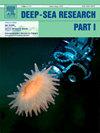Spatial variation of diapycnal mixing estimated from high-resolution seismic images of subsurface eddies, Bering Sea
IF 2.1
3区 地球科学
Q2 OCEANOGRAPHY
Deep-Sea Research Part I-Oceanographic Research Papers
Pub Date : 2025-09-27
DOI:10.1016/j.dsr.2025.104601
引用次数: 0
Abstract
Turbulent mixing is a primary physical process responsible for vertical exchange of materials, heat, momentum, and energy in the ocean, and plays a key role in maintaining the overturning circulation. There are many ways to enhance ocean mixing, one of which is through oceanic eddies. However, sparse in-situ observations cannot accurately describe the structural characteristics of eddies and their contribution to turbulent mixing in the Bering Sea. In this study, we observed numerous subsurface eddies in the deep-sea region of the Bering Sea using high-resolution seismic images. These anticyclonic eddies are primarily oval-shaped or bowl-shaped, with horizontal scales of 7–65 km. The majority fall within the submesoscale range, suggesting they are mainly submesoscale eddies. They generally develop in waters shallower than 250 m, with only a few found below 300 m. Submesoscale filaments are observed on the flanks of these eddies, some of which extend downward from the eddy sides, appearing as inclined filamentous reflections. Using seismic data, we estimated diapycnal mixing and obtained its spatial distribution. The results reveal that diffusivity is significantly enhanced at the edges of eddies, especially along their sides and upper boundaries, with values reaching up to 10−3 m2 s−1. The enhanced diapycnal mixing may be related to submesoscale processes generated during eddy stirring and shear instability caused by eddy-induced velocities. Turbulent mixing induced by eddies promotes the vertical transport of heat, nutrients, and other substances in the ocean, thereby influencing primary productivity in the Bering Sea and significantly impacting the marine environment and ecosystem.
白令海地下涡旋高分辨率地震图像估算的地表旋流混合的空间变化
湍流混合是海洋中物质、热量、动量和能量垂直交换的主要物理过程,在维持倾覆环流中起着关键作用。增强海洋混合的方法有很多,其中之一就是通过海洋涡流。然而,稀疏的原位观测不能准确描述白令海涡旋的结构特征及其对湍流混合的贡献。在这项研究中,我们使用高分辨率地震图像观察了白令海深海地区的许多地下漩涡。这些反气旋涡旋主要呈椭圆形或碗形,水平尺度为7-65公里。大多数在亚中尺度范围内,表明它们主要是亚中尺度涡旋。它们一般生长在250米以下的水域,只有少数生长在300米以下。在这些涡旋的侧面观察到亚中尺度细丝,其中一些从涡旋侧面向下延伸,表现为倾斜的丝状反射。利用地震资料,估计了河床混合作用,得到了其空间分布。结果表明,涡旋边缘的扩散系数显著增强,特别是沿涡旋边缘和上边界的扩散系数可达10−3 m2 s−1。湍流混合的增强可能与涡旋搅拌过程中产生的亚中尺度过程和涡旋诱导速度引起的剪切不稳定有关。涡流引起的湍流混合促进了海洋中热量、营养物质和其他物质的垂直输送,从而影响了白令海的初级生产力,对海洋环境和生态系统产生了重大影响。
本文章由计算机程序翻译,如有差异,请以英文原文为准。
求助全文
约1分钟内获得全文
求助全文
来源期刊
CiteScore
4.60
自引率
4.20%
发文量
144
审稿时长
18.3 weeks
期刊介绍:
Deep-Sea Research Part I: Oceanographic Research Papers is devoted to the publication of the results of original scientific research, including theoretical work of evident oceanographic applicability; and the solution of instrumental or methodological problems with evidence of successful use. The journal is distinguished by its interdisciplinary nature and its breadth, covering the geological, physical, chemical and biological aspects of the ocean and its boundaries with the sea floor and the atmosphere. In addition to regular "Research Papers" and "Instruments and Methods" papers, briefer communications may be published as "Notes". Supplemental matter, such as extensive data tables or graphs and multimedia content, may be published as electronic appendices.

 求助内容:
求助内容: 应助结果提醒方式:
应助结果提醒方式:


